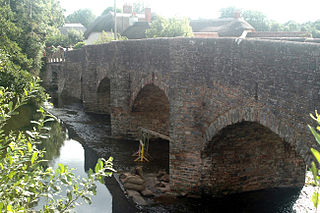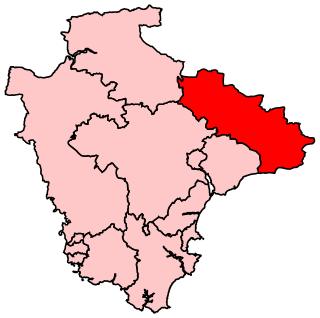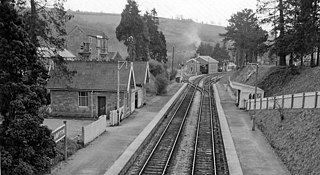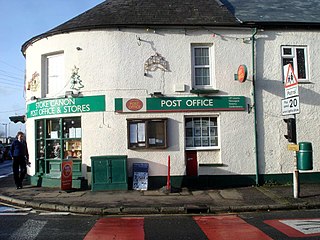
Richard Doddridge Blackmore, known as R. D. Blackmore, was one of the most famous English novelists of the second half of the nineteenth century. He won acclaim for vivid descriptions and personification of the countryside, sharing with Thomas Hardy a Western England background and a strong sense of regional setting in his works.

Mid Devon is a local government district in Devon, England. Its council is based in Tiverton.

Tiverton is a town and civil parish in the English county of Devon and the main commercial and administrative centre of the Mid Devon district. It has become a dormitory town for Exeter and Taunton. The estimated population in 2019 was 20,587. The total area of the two County Council Divisions had a population of 38,191 in 2019.

Ilsington is a village and civil parish situated on the eastern edge of Dartmoor, Devon, England. It is one of the largest parishes in the county, and includes the villages of Ilsington, Haytor Vale, Liverton and South Knighton. The parish is surrounded, clockwise from the north, by the parishes of Bovey Tracey, Teigngrace, Newton Abbot, Ogwell, Bickington, Ashburton, Widecombe-in-the-Moor and Manaton. In 2001 the population of the parish was 2,444, greatly increased from the 886 residents recorded in 1901. The parish is represented in parliament by Mel Stride, as part of the Central Devon constituency.

Cullompton is a town and civil parish in the district of Mid Devon and the county of Devon, England. It is 13 miles (21 km) north-east of Exeter and lies on the River Culm. In 2011 the parish as a whole had a population of 8,499 while the built-up area of the town had a population of 7,439.

Plymtree is a small village and civil parish about 3.5 miles south of the town of Cullompton in the county of Devon, England. The parish is surrounded, clockwise from the north, by the parishes of Broadhembury, Payhembury, Clyst Hydon and Cullompton. In 2001 it had a population of 605, compared to 359 in 1901. The village website provides up to date information about local events http://www.plymtree.org.uk/

Hemyock is a village and civil parish in Devon, England. It is about 8 miles north-west of Honiton and 5 miles (8 km) south of the Somerset town of Wellington. The 2011 Census recorded the parish's population as 1,519. Hemyock is part of the electoral ward of Upper Culm. The population of this ward at the above census was 4,039. The River Culm flows through Hemyock. Hemyock was the former home of the St Ivel dairy processing plant, formerly where the butter-spreads 'St Ivel Gold' and 'Utterly-Butterly' were produced before being moved to a factory in the north of England.

The River Culm flows through the Devon Redlands in Devon, England and is the longest tributary of the River Exe. It rises in the Blackdown Hills at a spring near RAF Culmhead in Somerset, and flows west through Hemyock, then Culmstock to Uffculme. The river turns south, through Cullompton, skirting the northern boundary of Killerton Park to join the River Exe on the north-western outskirts of Exeter. The name of the river is thought to mean 'knot' or 'tie', in reference to the river's twists and loops.

The Blackdown Hills are a range of hills along the Somerset-Devon border in south-western England, which were designated an Area of Outstanding Natural Beauty (AONB) in 1991.

Tiverton and Honiton is a constituency in Devon represented in the House of Commons of the UK Parliament since 2010 by Neil Parish, a Conservative.

Silverton is a large village and civil parish, about 8 miles (13 km) north of Exeter, in the English county of Devon. It is one of the oldest villages in Devon and dates from the first years of the Saxon occupation.

Willand is a village and civil parish within the Local Government district of Mid Devon, England.

Uffculme is a village and civil parish located in the Mid Devon district, of Devon, England. Situated in the Blackdown Hills on the B3440, close to the M5 motorway and the Bristol–Exeter railway line, near Cullompton, Uffculme is on the upper reaches of the River Culm. The population of the parish, according to a 2020 estimate, is 3,090. It is surrounded, clockwise from the north, by the parishes of Culmstock, Hemyock, Sheldon, Kentisbeare, Cullompton, Willand, Halberton and Burlescombe.
There are 22 disused railway stations in the 75 miles (121 km) between Bristol Temple Meads and Exeter St Davids, 12 of which have structures that can still be seen from passing trains. Most were closed in the 1960s but four of them, especially around Weston-super-Mare, were replaced by stations on new sites. 13 stations remain open on the line today, but there have been proposals to reopen stations at Cullompton and Wellington.

The Exe Valley Railway was a branch line built by the Great Western Railway (GWR) in Devon, England, to link its Bristol to Exeter line with its Devon and Somerset Railway (D&SR), thereby connecting Exeter with Dulverton. The line was in use from 1884 until 1964.

Stoke Canon is a small village and civil parish near the confluence of the rivers Exe and Culm on the main A396 between Exeter and Tiverton in the English county of Devon, and the district of East Devon. At the 2001 census it had a population of 660. The population was unchanged in 2011 but the village forms the major part of the Exe Valley electoral ward. The population of this ward was 2,041 at the 2011 Census.

Rewe is a village and civil parish in the county of Devon in England. It lies on the river Culm, 5 miles (8 km) north of the city of Exeter and 9 miles (14 km) south of the town of Tiverton. Rewe is a linear village, with most of its buildings lying along the A396 road about 1 mile (1.6 km) north of the larger village of Stoke Canon. The Reading to Plymouth railway line also passes through the village, but there has never been a station here; the nearest operating station is Exeter St Davids. Before its closure, Stoke Canon station was the nearest.

The Culm Valley Light Railway was a standard gauge branch railway that operated in the English county of Devon. It ran for just under 7+1⁄2 miles (12.1 km) from Tiverton Junction station on the Bristol to Exeter line, through the Culm valley to Hemyock.

Hemyock Castle is a ruined 14th-century castle in the village of Hemyock, Devon, England. It was built by Sir William Asthorpe after 1380 to a quadrangular design. It would have been visually impressive, but not particularly functional, with various intrinsic flaws. By the 16th century it had fallen into ruin and, following its use during the English Civil War in the mid-17th century, it was pulled down (slighted). In the 21st century the site is occupied by the fragments of the original castle; and Castle House, an 18th-century house built within the site, and restored as private home at the end of the 20th century.

Perlycross: a tale of the western hills is a three-volume novel by R. D. Blackmore published in 1894. The story is set in eastern Devon around 1830.




















